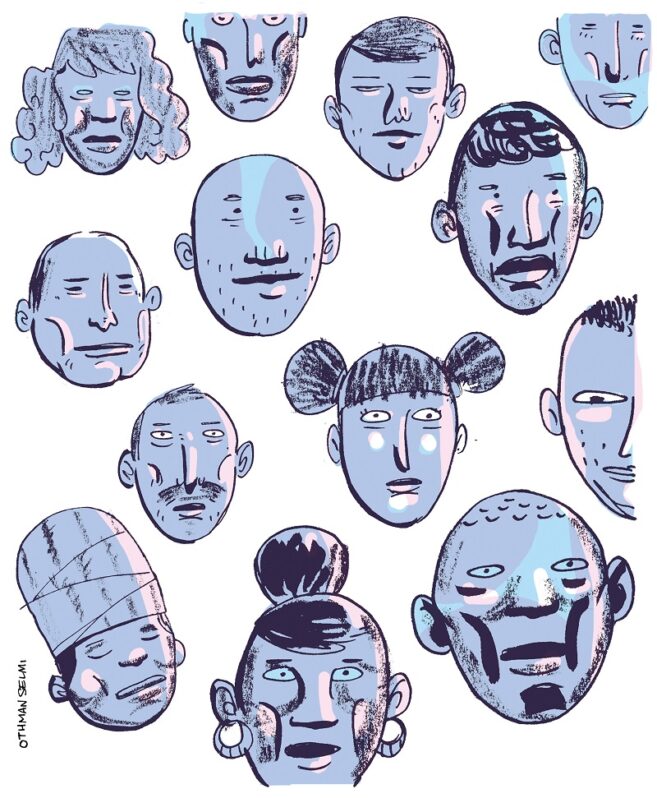Tunisia’s Water Deficit: How Did the State Help Create Thirst?

This wet season in Tunisia (October-March) ended with the poorest yield in years. The water level of the dams barely reached 30%. For weeks, images and videos of virtually empty water facilities, cracked earth, and yellow fields, along with talk of drought, thirst, and aridity, have been sweeping the media and social media. Apocalypse now, or soon. Since fall 2019, Tunisia has experienced four years of continuous drought. At the beginning of 2023, officials in the Ministry of Agriculture, Water Resources, and Fisheries (hereinafter the Ministry of Agriculture) delivered frequent statements emphasizing the gravity of the country’s “water deficit” and forewarning of “water emergency” measures.
Since mid-March 2023, interruptions in the supply of drinking water have been recurrent and expanded to several regions not previously suffering such distribution disturbances. These interruptions occurred with no notice or explanation from the National Water Distribution Utility (SONEDE). Their concurrence with the arrival of the holy month of Ramadan further infuriated the people affected. In reality, the state had begun applying a system of “water rations” but only officially announced it on March 29 via a decision issued by the Ministry of Agriculture. The decision banned the use of drinking water to irrigate agricultural lands, water green spaces, or clean streets, buildings, and cars and stipulated that drinking water distributed via SONEDE’s networks be rationed for all users until September 30. It also included a collection of financial and custodial penalties for violators. The ministry justified these measures on the basis that “the successive years of drought and poor intake of the dams have negatively affected their water storage, which has reached an unprecedented level”.
Certainly, Tunisia is suffering its share of the effects of global climate change. However, these years of drought – along with famines – are not unprecedented in modern Tunisian history.[1] Examples include the “Year of Rice” (1936-1938) and the “Year of Hunger” (1945-1946). Barely a decade passes without a drought lasting one to several years, sometimes confined to several provinces and sometimes encompassing the whole country. The longest and harshest droughts occurred in the 1920s, 1940s, 1960s, and at the end of the 1980s.
The country’s average annual precipitation is approximately 207mm, which equates to more than 30 billion m3 of water. Despite the huge investments and efforts that the Tunisian state has made since independence, the combined capacity of the enormous water infrastructure (approximately 40 dams, more than 250 mountain dams, and approximately 1,000 mountain lakes) is no more than 2.8 billion m3. The remaining precipitation disappears into the land, air, or sea. Thus, the drought that Tunisia is now experiencing is not the first and will not be the last, and droughts may become more frequent in future.
Even the cutting-off of drinking water and water rationing are not unprecedented. The intermittent interruptions to drinking water over months announced in the ministry’s decision are a reality that hundreds of thousands of Tunisians have been living for many years. Each year, we see dozens, sometimes hundreds, of protests demanding the constitutional right to water in several parts of the country, especially in the middle and the south. We need only view the “thirst maps” periodically published by the Tunisian Water Observatory to comprehend the scope of water inequity that many Tunisians face. The new rationing system is part of what could be called the universalization of injustice.
The Ministry of Agriculture: Constantly Searching for the “Culprit”
Logically, the Ministry of Agriculture – which manages the water portfolio – is searching for the causes of this deficit and trying to reduce it. The problem is that this search resembles police investigations in countries that disregard detainees’ rights and the presumption of innocence. It focuses on the most vulnerable “suspects” and attempts to hold them responsible for the “crime”. Since the early 1990s, the discourse about “careless” citizens who waste rivers of drinking water when they wash their face, brush their teeth, or clean their clothes or dishes has circulated. The archive of national television (RTT, then Channel 7) from that period contains many awareness-raising advertisements scolding wasteful citizens and warning them that one day they will not find a drop of water when they turn on the tap.
Likewise, SONEDE’s Facebook page features posts urging citizens to “rationalize their consumption behavior” and threatening them with thirst. A few minutes on the page is enough to form a strong impression that most Tunisians own pools, wash their cars and shower several times daily, and take great pleasure in gawking at the tap water pointlessly running for minutes on end. Irrational consumption of drinking water, then, is the biggest “crime”. Whoever commits it (the regular citizen) must be punished by cutting off their water for hours every day, and material compensation must be obtained by raising the price of drinking water every two or three years. This “criminalizing” discourse neglects important details:
- The water resources allocated for domestic use (drinking, cooking, sanitation) represent only 10-15% of all resources used, whereas agriculture accounts for approximately 80% of water resources drawn annually.
- Approximately one third of drinking water is lost “in transit” before reaching the consumer. For example, according to a SONEDE report, in 2019 the company pumped 758.6 million m3 through its networks, but only 508.1 million m3 reached consumers. Hence, 250.7 million m3 were lost at the production and distribution stages (38% at the former and 61% at the latter).
- Approximately 60% of SONEDE’s networks are 30-50 years old. This partially explains the large number of equipment and pipe breakages (over 19,000 in 2019) and drinking water leaks (over 21,000 in 2019).
The second major “culprit”, according to the water discourse prevailing in governmental departments and even among many experts, is the “water associations”. This discourse was popular following the revolution, especially between 2015 and 2018, when the state was preparing a new water code. These associations (linked to the agricultural development groups) appeared in the late 1980s. They were supposed to play a large socioeconomic role in developing rural regions by providing irrigation water to farms and drinking water to areas not reached by SONEDE’s networks. The establishment of these associations, their geographical distribution, and the appointment of their administrators helped serve political ends during former president Zine El Abidine Ben Ali’s rule. They were a means of constructing clientelist networks and propagandizing for the regime. The number of these associations reached approximately 2,500 shortly before the 2011 revolution. However, in recent years it gradually declined such that only 1,400-1,500 remain. Most are suffering major problems such as the accumulation of debts to the Tunisian Company of Electricity and Gas (STEG); aging or failing electrical generators, pumps, and other equipment; the absence of technicians and experts among their administrators; and cases of vandalism and illegal use of the extracted water. Some experts estimate that water wastage in the associations’ production and distribution networks stands at 40-50%. For many years, these facilities – which are extremely strategically important in the rural milieu – were administered haphazardly by amateurs and occasionally by people engaging in corruption or seeking state salaries. Several civil society organizations are calling for the creation of a national agency to fully oversee the water associations in a regular and scientific manner that breaks with the old practices – a “SONEDE” for the countryside.
The third “culprit” is the cross-continental one: climate change. However, did the climate change drastically between 1923 and 2023? And if we grant that precipitation was more abundant a century ago, we cannot deny that the state’s ability to store and treat water has improved greatly thanks to dams, mountain lakes, artificial lakes, and other facilities. So why did resources become “scarce” leading to a water “deficit”? The size of Tunisia’s population did not even increase at a dramatic pace, climbing from approximately 4.5 million people in 1963 to approximately 12 million in 2023. Perhaps we need to search elsewhere for potential “culprits”…
The Roots of the Water Crisis
The discussion about water scarcity in Tunisia largely revolves around drinking water and resources allocated to the tourism and industrial sectors. Combined, these uses – despite the wastage associated with them – account for only 20-25% of all resources drawn annually. Agricultural activity accounts for over three quarters of water resources in Tunisia, a distinctly agrarian country. Given this enormous share going to the agricultural sector, citizens’ baskets and bellies should be full of their country’s delicious bounties. Yet this is untrue, especially during the past two decades. Citizens usually subsist off imported soft wheat bread, pastries derived from imported hard wheat, inferior imported vegetable oils, sweets, juices full of imported sugar, and few locally produced vegetables, meats, and poultry. A significant portion of the population cannot buy olive or date oil even though the country is a major producer and exporter. The same goes for red meats and fish despite the abundant local production. If most Tunisians cannot get enough diverse and healthy food with decent taste and quality and at reasonable prices, then the country’s agricultural policies are defective. Where does all this produce, and all the water allocated to agriculture, go?
Since the early 1970s – i.e. after the agricultural cooperatives experiment and the turn toward economic “openness” – the Tunisia state has opted to focus on producing olive oil, citrus fruits (which offset vineyards and wines in the northeast), dates, off-season vegetables, and certain other fruits (even strawberry and rose hips), which are all goods that are easier to export but require large quantities of water to produce. This choice came at the expense of grains, legumes, and several staple products. In this regard, the state did not deviate much from the policies of agricultural colonialism that France applied while it occupied Tunisia (1881-1956). The state also encouraged the production of meats and dairy and subsidized the food processing industries. The objective of these policies was to modernize agriculture, increase its added value, create jobs, and bring as much hard currency as possible in accordance with the principle of comparative advantages. In parallel with these agricultural policies, Tunisia adopted a policy of low-cost tourism and managed to attract millions of European tourists annually, which increased demand on food and water resources. Since the 1980s, it has also gradually abandoned support for small farmers while supporting investors and large producers, i.e. “business” agriculture.
Because of all these choices, water consumption in Tunisia witnessed great leaps over the past fifty years. For example, irrigation spaces, which spanned no more than 50,000 hectares in the late 1960s, now span approximately half a million hectares, whereas the population only increased 1.5 times over the same period. Today, wells for extracting groundwater number more than 35,000, with more than 60% dug without a license. Small farmers resort to this solution primarily because of the scarcity or high cost of “legal” water resources. Most do so to preserve their land and withstand asymmetrical competition with large agricultural investors.
The state’s persistence with agricultural-commercial policies, whose foundations trace back more than half a century, would be acceptable if it had achieved food sovereignty, satisfied its citizens’ needs, and possessed vast water resources. However, given the rising bill of the food deficit and deteriorating purchasing power, declaring a “water emergency” is an attack on most Tunisians’ right to water and nutrition for the benefit of a minority consisting of agricultural investors. It is a flagrant injustice against small farmers and small consumers of drinking water, who are being punished and asked to make sacrifices to adapt to a crisis they did not cause.
Nontraditional Water Resources: Feasible Solutions or Kicking the Can Down the Road?
Given all this talk of water poverty and thirst, the state naturally looked for solutions to compensate for the natural resource “shortage” and mobilize new resources. The most notable of these solutions employed in Tunisia are the purification and reuse of greywater (domestic wastewater) and the desalination of salty groundwater and seawater.
According to data from the National Sanitation Utility for 2019, 22% of treated wastewater (62 million m3 of a total 285 million m3) was reused. Tunisia also began desalinating groundwater in 1983 by constructing desalination plants in various regions. The total production capacity of these plants is approximately 100,000 m3 per day. As for seawater desalination, the experiment is still in its early stages.
While the material and environmental cost of treating greywater is relatively low, the cost of desalination, especially of seawater, is very high. This method involves power-hungry technologies that require significant financial investments and have ecological ramifications, such as the depositing of toxic sludge into the ocean and its ecosystems.
Some people see these “nontraditional” solutions as magic bullets. However, even if we overlook the environmental aspect, their material cost is very high. They could constitute solutions for countries suffering from abject water poverty and enjoying a large financial surplus. But for Tunisia, the bill seems unaffordable. Meanwhile, there is still the question of whether we really need these technologies and whether reliance on them is inevitable. Would it not have been better to revise our agricultural policies, lifestyle, and consumption?
Conclusion
The water crisis in Tunisia is primarily the result of a failure in the governance of a natural resource and a mindset fixed on investment and quick profits. Water is a distinctly political issue that cannot be fully surrendered to technocrats and bureaucrats. The path to water security requires treating water as a public good for all Tunisians that they enjoy on equal footing and conserve for future generations. Undoubtedly, reorienting agricultural policies is difficult and complicated and comes at a high sociopolitical cost, but the toll of not revising and changing will be far higher.
This article is an edited translation from Arabic
[1] For further reading, see:
- Latifa Hénia, Les grandes sécheresses en Tunisie au cours de la dernière période séculaire, in EAU ET ENVIRONNEMENT: Tunisie et milieux méditerranéens, ENS ÉDITIONS, Lyon, 2003.
- Zeineb Benzarti, La pluviométrie en Tunisie. Analyse des années très pluvieuses, in EAU ET ENVIRONNEMENT: Tunisie et milieux méditerranéens, ENS ÉDITIONS, Lyon, 2003.



